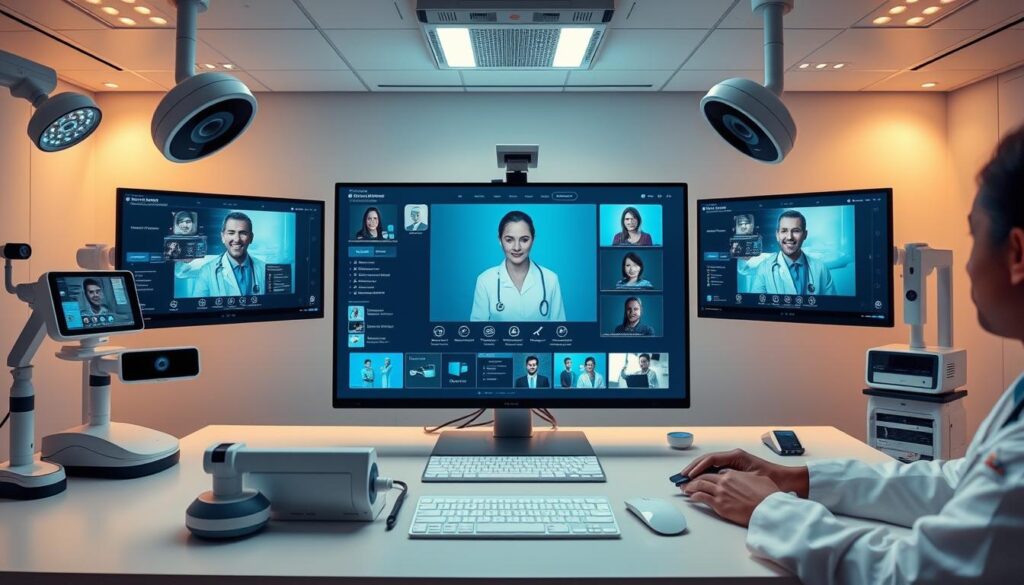Did you know that the average salary for Telehealth Providers exceeds $200,000 per year? This is just one example of how the healthcare industry is evolving to embrace remote opportunities1.
The shift towards remote roles in healthcare is reshaping how professionals work. From virtual clinical educators to medical coders, these positions offer flexibility and the chance to make a difference from home2.
These roles require strong communication skills and empathy, whether you’re analyzing data or supporting patients directly. Companies like Carenet Health are leading the way, creating new career paths in this growing field.
In this article, I’ll explore the benefits and challenges of remote healthcare jobs. You’ll also discover how to find opportunities that fit your skills and lifestyle. Let’s dive in!
Overview of Remote Healthcare Jobs
The rise of virtual care has opened doors to countless opportunities in the medical field. These roles allow professionals to provide essential services from the comfort of their home, making it easier to balance work and personal life.
What Are Virtual Medical Roles?
Virtual medical roles involve providing care or support through digital platforms. Whether it’s consulting with a patient via video call or analyzing medical data, these positions rely on technology to bridge the gap between professionals and those they serve.
For example, a telehealth provider might conduct virtual consultations, while a medical coder ensures accurate billing from a home office. These roles require strong communication skills and a deep understanding of medical practices.
Telehealth Industry Growth
The demand for virtual medical professionals has surged in recent years. Companies like Teladoc Health reported over 10 million virtual visits in 2021, showcasing the rapid adoption of telehealth services3.
This growth is driven by advancements in technology and a focus on cost-effective care. For instance, CVS Health reduced billing errors by 15% after transitioning medical coders to remote positions3.
Understanding these roles is essential for anyone looking to enter this field. From addiction counselors to medical writers, the opportunities are vast and varied. Employers are also prioritizing candidates with knowledge of HIPAA regulations and digital platforms like Epic and Cerner3.
As the industry continues to evolve, virtual medical roles will remain a central hub for innovation. Whether you’re a seasoned professional or just starting, these positions offer a chance to make a difference while working from home.
Main Benefits of Working in Remote Healthcare
Flexibility is one of the most sought-after benefits in today’s professional landscape. Remote roles in the medical field offer unparalleled freedom, allowing professionals to design their ideal workday. Whether you’re managing patient care or analyzing data, these positions provide a unique blend of autonomy and purpose.
Flexibility and Work-Life Balance
One of the standout advantages of remote medical roles is the ability to achieve a healthy work-life balance. Professionals can choose from full-time, part-time, or freelance opportunities, tailoring their schedules to fit personal commitments. This flexibility reduces stress and enhances overall well-being4.
Geographic independence is another key benefit. You can work from anywhere, whether it’s your home office or a co-working space. This eliminates the need for long commutes, saving both time and money. Studies show that reduced commuting costs can increase disposable income by up to 15%5.
Employers are also stepping up to support work-life integration. Many companies offer hybrid work models, combining remote and in-office days. This approach ensures professionals stay connected while enjoying the perks of working from home.
Technology plays a crucial role in making these roles efficient. Platforms like Epic and Cerner streamline patient interactions, allowing for real-time data sharing and collaboration. This not only improves workflow but also enhances patient care4.
| Benefit | Impact |
|---|---|
| Flexible Scheduling | Improved work-life balance |
| Geographic Independence | Reduced commuting costs |
| Hybrid Work Models | Enhanced team collaboration |
| Technology Integration | Efficient patient care |
Remote medical roles are not just about convenience; they’re about creating a sustainable and fulfilling career. By prioritizing flexibility and leveraging technology, professionals can thrive in this evolving field. The competitive advantages of these positions make them a top choice for those seeking a balanced and impactful career.
Types of Remote Healthcare Roles Available
From patient care to data management, virtual roles are reshaping the industry. These positions span clinical and administrative functions, offering professionals the chance to make an impact from anywhere. Whether you’re directly supporting patients or managing behind-the-scenes operations, there’s a role that fits your skills.
Clinical Positions
Clinical roles focus on direct patient care and medical expertise. For example, a telehealth provider conducts virtual consultations, diagnosing and treating patients remotely. These positions require strong communication skills and a deep understanding of medical practices1.
Another example is a virtual clinical educator, who trains medical staff on new protocols and technologies. These roles often require certifications and hands-on experience in the field6.
Administrative Roles
Administrative positions ensure the smooth operation of medical services. A certified coder, for instance, translates medical procedures into billing codes, ensuring accurate reimbursement. This role demands attention to detail and knowledge of coding systems1.
Other administrative roles include patient care coordinators and call center representatives. These positions rely heavily on customer service skills to assist patients with scheduling, billing, and other inquiries7.
Both clinical and administrative roles emphasize the importance of empathy and technical expertise. Whether you’re working full-time or part-time, these positions offer a chance to contribute to the health industry while enjoying flexibility.
Exploring Work-from-Home Opportunities in Healthcare
The shift to digital platforms has created diverse work-from-home opportunities in the medical sector. Whether you’re seeking stability or flexibility, there’s a role tailored to your needs. From full-time positions to freelance gigs, the options are vast and varied.

Full-Time vs Part-Time Options
Full-time roles offer stability and comprehensive benefits, including insurance and retirement plans. These positions often require a commitment of 40 hours per week, making them ideal for those seeking long-term security8.
Part-time roles, on the other hand, provide flexibility for those balancing other commitments. They’re perfect for students, caregivers, or anyone looking to supplement their income. Many part-time positions still offer access to essential services like training and support9.
Freelance and Contract Opportunities
Freelance and contract roles are ideal for professionals who value autonomy. These positions allow you to set your own hours and choose projects that align with your expertise. For example, medical writers and transcriptionists often work on a project basis8.
However, these roles may lack traditional benefits like insurance or paid leave. It’s essential to weigh the pros and cons before committing. Many companies, including staffing agencies, offer hybrid models that combine the flexibility of freelance work with the security of a contract9.
Ultimately, the choice between full-time, part-time, or freelance work depends on your lifestyle and career goals. Each option has its unique advantages, so take the time to evaluate which arrangement best fits your needs.
Effective Strategies to Find Remote Healthcare Jobs
Finding the right position in the medical field from home requires a strategic approach. With the growing demand for virtual roles, knowing where and how to look can make all the difference. Whether you’re seeking full-time or part-time opportunities, these methods will help you navigate the job market effectively.
Utilizing Online Job Boards
Online job boards are a powerful tool for discovering work-from-home roles. Platforms like Indeed, Glassdoor, and LinkedIn regularly list openings in the medical sector. To maximize your search, use specific keywords such as “virtual medical assistant” or “telehealth provider.”
Optimizing your resume and profile is crucial. Include metrics like patient satisfaction scores or efficiency improvements to stand out. Studies show that 36% of resumes lack metrics, which can reduce your chances of landing an interview10.
Stay updated with job listings by setting up alerts. This ensures you’re among the first to apply, increasing your chances of success. Remember, applying online has a 2% success rate, so persistence is key10.
Networking and Recruitment
Networking plays a vital role in securing remote roles. Attend virtual career fairs or join professional groups on LinkedIn. Building connections with recruiters can open doors to unadvertised positions.
Reach out to recruiters directly with a tailored message. Highlight your skills and express your interest in work-from-home opportunities. Many recruiters specialize in placing candidates in virtual roles, making them valuable allies.
Consider hybrid work models as well. These positions offer flexibility while keeping you connected to a team. With 51% of professionals preferring fully remote roles, competition is fierce, but networking can give you an edge11.
By combining online job boards with proactive networking, you can increase your chances of finding the perfect role. Dedicate time to refining your approach, and you’ll be well on your way to a fulfilling career from home.
Building a Competitive Remote Healthcare Career
Building a competitive edge in telehealth requires strategic preparation. Whether you’re crafting a resume or preparing for an interview, showcasing your skills effectively is key. Let’s explore how to stand out in this growing field.
Crafting a Strong Resume
Your resume is your first impression. Highlight both clinical expertise and remote work capabilities. For example, Teladoc Health values candidates who demonstrate proficiency in telehealth platforms3.
Tailor your cover letter to emphasize your ability to deliver high-quality care virtually. Include metrics like patient satisfaction scores or efficiency improvements. Studies show that resumes with metrics are 36% more likely to secure interviews3.
Continuous learning is also crucial. Certifications in telehealth or EHR systems can significantly boost your resume. Employers prioritize candidates with multiple state licenses, especially in high-demand areas like California and Texas3.
Mastering the Interview Process
Interviews for virtual roles often focus on technical and soft skills. Be prepared to discuss your experience with platforms like Epic or Cerner. CVS Health, for instance, looks for candidates who can streamline claims processing12.
Practice articulating your value confidently. Share examples of how you’ve improved patient outcomes or enhanced team collaboration. Employers value professionals who can balance autonomy with teamwork.
Finally, showcase your commitment to professional development. Engaging in webinars or workshops demonstrates your dedication to staying current in the field. This not only enhances your skills but also improves your quality of life by fostering personal growth13.
Remote Healthcare Jobs Opportunities
The demand for virtual medical professionals continues to grow, offering diverse opportunities across the U.S. From telemedicine experts to administrative specialists, these roles provide flexibility and competitive salaries. Companies like FreedomCare and Inizio Engage are leading the charge, creating new pathways for professionals to thrive from home.
Current Openings and Trends
One of the most significant trends is the increasing need for telemedicine experts. Positions like Health Coach Specialist and Addiction and Recovery Counselor II are in high demand, with hourly wages ranging from $20 to $266. These roles often require strong communication skills and a commitment to patient care.
Full-time roles, such as Senior Digital FPGA Design Engineer, offer annual salaries between $145,000 and $173,0006. On the other hand, contract positions like Certified Coder provide flexibility, with hourly rates up to $556. Employers are also prioritizing candidates with expertise in digital platforms and regulatory compliance.
Another emerging trend is the focus on geographic diversity. Job listings span multiple states, including Arizona, Texas, and California14. This broad distribution ensures professionals can find roles that fit their location and lifestyle.
For those seeking stability, full-time positions often include comprehensive benefits like insurance and retirement plans. Part-time and freelance roles, however, cater to individuals balancing other commitments. For example, Medical Writers can earn up to $160,000 annually while working on a project basis6.
To explore these opportunities, I recommend checking out remote medical roles at Molina Healthcare. Their listings include positions like Manager of Member Services and Clinical Supervisor, offering competitive salaries and flexible schedules.
As the industry evolves, staying informed about market trends is crucial. Whether you’re a seasoned professional or just starting, these roles provide a chance to make a meaningful impact while enjoying the benefit of working from home.
Leveraging Technology in Remote Healthcare
Technology is reshaping how medical services are delivered, making virtual care more accessible than ever. From advanced platforms to innovative tools, these solutions are transforming the way specialists interact with patients. Let’s explore how these technologies enhance quality and efficiency.

Key Telemedicine Platforms
Platforms like Epic and Cerner are widely used in virtual medical services. These systems streamline patient data management, ensuring accurate and timely care. For example, Carenet Health utilizes these tools to improve inbound outbound communication with patients15.
Another example is Teladoc Health, which reported over 10 million virtual visits in 2021. This platform enables representatives to conduct consultations efficiently, reducing wait times and improving patient satisfaction16.
Innovative Tools for Diagnosis and Treatment
Wearable devices and mobile health apps are revolutionizing remote diagnosis. These tools provide continuous health monitoring, allowing specialists to track patient data in real-time. For instance, wearable devices can monitor heart rates and blood pressure, sending alerts for any abnormalities16.
AI-driven tools are also gaining traction. They automate routine tasks like scheduling and data analysis, freeing up time for representatives to focus on patient care. This not only enhances efficiency but also improves job satisfaction15.
Communication Tools for Patient Engagement
Secure video conferencing tools are essential for maintaining patient-provider relationships. Platforms like Zoom for Healthcare ensure privacy while facilitating face-to-face interactions. These tools are particularly beneficial for managing chronic conditions, as they allow for regular check-ins16.
Messaging apps and patient portals also play a crucial role. They enable seamless communication, allowing patients to ask questions, refill prescriptions, and schedule appointments without leaving their homes15.
Staying Current with Technology Trends
To thrive in this evolving field, it’s essential to stay updated on the latest tools and platforms. Regularly attending webinars and earning certifications in telehealth can give you a competitive edge. Companies like Carenet Health often provide training to ensure their teams are proficient in the latest technologies15.
By leveraging these tools, you can enhance the quality of care while enjoying the flexibility of virtual work. Embrace these innovations to make a meaningful impact in the medical field.
Navigating Certification and Licensing Requirements
Navigating the certification and licensing landscape is crucial for success in virtual medical roles. Whether you’re a seasoned professional or a new graduate, understanding these requirements ensures you’re eligible for the positions you want. Let’s break down what you need to know.
Understanding State Regulations
State regulations play a significant role in determining your eligibility for virtual roles. For example, New York is not part of the Nurse Licensure Compact (NLC), requiring nurses to obtain a New York RN license for remote positions17. This means you’ll need to research the specific rules for your state before applying.
Employers often adapt to these differences by offering support for licensure. For instance, the Interstate Medical Licensure Compact (IMLC) allows Radiologists to apply for additional licenses in any of the 37+ participating states through an expedited process18. This simplifies the process for professionals working across state lines.
Steps to Obtain and Maintain Licenses
Obtaining a license involves several steps, including completing the required education, passing exams, and submitting applications. For example, Radiologists must hold a full, unrestricted medical license in one of the Compact’s participating states, referred to as the “State of Principal Licensure” (SPL)18.
Maintaining your license often requires continuing education and periodic renewals. Staying updated on these requirements ensures you remain compliant and eligible for work. Companies like Epic Diagnostics & Imaging Services offer support for managing this process, including application management and fingerprinting assistance18.
Recent Changes in Accreditation Standards
Accreditation standards are constantly evolving. For example, the demand for telehealth nurses, case managers, and utilization review nurses is rising, indicating a growing job market for remote nursing positions in New York17. This trend highlights the importance of staying informed about industry changes.
Recent updates to the IMLC have also streamlined the licensing process, making it easier for professionals to work in multiple states. The Letter of Qualification (LOQ) is essential for accessing these benefits, confirming eligibility for expedited licensure in other Compact states18.
Implications for Full-Time and Part-Time Employment
Licensing requirements can impact your employment options. Full-time roles often require comprehensive licensure, while part-time or freelance positions may have more flexible requirements. For example, Telehealth Nurse salaries in New York range from $85,000 to $110,000, compared to a national range of $75,000 to $95,00017.
Understanding these implications helps you choose the right path for your career. Whether you’re seeking stability or flexibility, proper licensure ensures you’re prepared for the opportunities available.
Guidance for New Graduates and Career Changers
If you’re new to the field or transitioning careers, start by researching the specific requirements for your desired role. For example, Clinical Documentation Specialist salaries in New York range from $80,000 to $98,000, while the national average is $72,000 to $90,00017. This data can help you set realistic expectations.
Additionally, consider seeking mentorship or professional guidance. Many organizations offer resources to help you navigate the licensing process and understand legal requirements. For more insights, check out this guide on building a successful career in virtual roles.
By mastering certification and licensing, you’ll position yourself for success in the growing field of virtual medical roles. Stay informed, stay compliant, and take advantage of the opportunities available to you.
Enhancing Patient and Customer Service Remotely
Delivering exceptional service in virtual settings requires mastering both communication and empathy. As a provider, your ability to connect with patients digitally can significantly impact their experience and outcomes. Let’s explore how to excel in these areas.

Effective Communication Techniques
Clear and concise communication is the backbone of any successful healthcare job. In virtual settings, this becomes even more critical. Active listening ensures patients feel heard, while detailed documentation prevents misunderstandings. For example, Carenet Health trains its teams to use structured scripts that maintain professionalism and clarity during calls.
Another key strategy is adapting your tone to the patient’s needs. A calm and supportive approach can ease anxiety, especially in sensitive situations. Studies show that empathetic communication reduces patient stress and improves satisfaction1.
Empathy in Virtual Care
Empathy is not just a soft skill—it’s a cornerstone of effective home healthcare. When patients can’t see you face-to-face, your words and tone become their primary connection. Phrases like “I understand how you feel” or “Let’s work through this together” can build trust and rapport.
Empathy also plays a role in reducing burnout among professionals. By fostering meaningful connections, you create a more fulfilling work environment. Companies like Carenet Health emphasize empathy training to ensure their teams provide compassionate care1.
Here are actionable steps to enhance your virtual service interactions:
- Practice active listening by summarizing the patient’s concerns.
- Use positive language to create a supportive atmosphere.
- Document interactions thoroughly to ensure continuity of care.
By mastering these techniques, you can deliver high-quality service that leaves a lasting impact. Whether you’re a provider or part of a call center team, these strategies will help you excel in your role.
Insights from Leading Remote Healthcare Companies
Leading companies in the medical field are redefining how care is delivered through innovative virtual solutions. These organizations are not only transforming patient outcomes but also creating rewarding career paths for professionals. Let’s explore some of the key players shaping this space.
Carenet Health Overview
Carenet Health stands out for its people-first culture and commitment to innovation. Their mission is to enhance patient engagement through cutting-edge technology and compassionate service. For example, they’ve implemented advanced platforms like Epic and Cerner to streamline communication and improve care delivery19.
Their focus on employee growth is equally impressive. Carenet Health offers extensive training programs and flexible work arrangements, making it a top choice for professionals seeking work-life balance. Roles like Enrollment Coordinator and Medical Office Scheduler are popular among associates looking to build a meaningful career20.
Other Influential Employers
Several other companies are making significant strides in telehealth. UnitedHealth Group, for instance, offers roles with salaries ranging from $50,000 to $120,000 annually, attracting top talent in the industry20. Similarly, Teladoc Health has become a leader in virtual consultations, with over 10 million visits reported in 202119.
Here’s a quick comparison of salary ranges for remote roles at top companies:
| Company | Salary Range |
|---|---|
| UnitedHealth Group | $50,000 – $120,000 |
| Teladoc Health | $70,000 – $150,000 |
| CVS Health | $45,000 – $100,000 |
| Amgen Inc. | $80,000 – $140,000 |
These companies are also known for their commitment to innovation. For example, CVS Health reduced billing errors by 15% after transitioning medical coders to remote positions19.
Career success stories abound in this field. One registered nurse transitioned to remote case management with Cigna, significantly increasing her qualifications through certification20. Another IT specialist moved into healthcare IT at Teladoc Health after completing an AWS certification20.
What sets these employers apart is their focus on quality patient care and employee satisfaction. By leveraging technology and fostering a supportive culture, they’re setting new standards in the industry. Whether you’re an experienced professional or just starting, these companies offer opportunities to grow and make a difference.
Optimizing Your Remote Work Environment
Creating an efficient workspace at home is the foundation of productivity in any virtual role. A well-structured home office not only boosts focus but also ensures you can deliver high-quality work consistently. Let’s explore how to set up a space that works for you.
Why a Dedicated Home Office Matters
A dedicated workspace helps separate work from personal life, reducing distractions and improving focus. Studies show that workers who use ergonomic setups experience less discomfort and higher productivity21. Whether you’re handling inbound calls or managing patient data, a structured environment is key.
Practical Tips for an Ergonomic Setup
Start with a comfortable chair that supports your posture. Your hips and knees should be at a 90-degree angle, and elbows positioned between 90 to 120 degrees when typing21. Pair this with a desk at the right height to avoid strain.
Proper lighting is equally important. Natural light reduces eye strain, while adjustable lamps can help during evening hours. Organize your desk to keep essentials within reach, minimizing unnecessary movements.
Technology Needs for Seamless Work
Invest in a reliable system that supports your tasks. Tools like Zoom and Slack are essential for communication, while platforms like Epic streamline data management22. Ensure your internet connection is stable to avoid disruptions during critical tasks.
Consider using productivity tools like Trello or Asana to manage projects efficiently. These platforms help prioritize tasks and track progress, ensuring you stay on top of deadlines22.
Daily Routines for Productivity
Establish a routine that mimics an office schedule. Start your day with a clear plan, and take regular breaks to avoid burnout. The 20/20/20 rule—focusing on an object 20 feet away for 20 seconds every 20 minutes—can reduce eye fatigue21.
Set boundaries to maintain work-life balance. Define specific work hours and stick to them, allowing time for personal activities and relaxation.
Examples from Professionals
Many successful virtual professionals recommend dual monitors for multitasking and noise-canceling headphones for focus. Others use standing desks to alternate between sitting and standing, reducing prolonged sitting discomfort21.
Actionable Suggestions for All Roles
Whether you’re in a clinical or administrative role, these tips apply:
- Use ergonomic furniture to prevent discomfort.
- Invest in reliable technology for seamless workflows.
- Maintain a routine to enhance productivity.

By optimizing your workspace, you can create a solution that enhances both efficiency and well-being. A well-designed home office is not just a luxury—it’s a necessity for thriving in virtual roles.
Improving Healthcare Outcomes Through Remote Work
Ensuring high-quality patient care in virtual settings is a top priority for medical professionals. With the rise of virtual roles, maintaining excellence in service delivery has become a shared goal between professionals and employers. Let’s explore how remote work can achieve the same outcomes as in-person care.
Best Practices for Virtual Patient Care
Clear communication is essential in virtual settings. Active listening and detailed documentation ensure patients feel heard and understood. For example, structured scripts help maintain professionalism during calls, reducing misunderstandings23.
Empathy plays a crucial role in building trust. Phrases like “I understand how you feel” create a supportive atmosphere, especially in sensitive situations. Studies show that empathetic communication reduces patient stress and improves satisfaction24.
Continuous Training and Technology Integration
Ongoing training ensures professionals stay updated on the latest tools and protocols. Platforms like Epic and Cerner streamline patient data management, improving efficiency and care delivery23.
Technology also enhances patient engagement. Wearable devices and mobile apps provide real-time health monitoring, allowing professionals to track patient data remotely24.
Using Metrics and Feedback for Improvement
Monitoring patient satisfaction and health data is key to continuous improvement. Metrics like patient satisfaction scores and efficiency rates help identify areas for enhancement23.
Feedback from patients and colleagues provides valuable insights. Regularly reviewing this feedback ensures services remain aligned with patient needs and expectations24.
Case Studies: Quality Outcomes in Remote Scenarios
One example is Carenet Health, which uses advanced platforms to improve patient engagement. Their focus on technology and training has led to higher satisfaction rates and better outcomes23.
Another case is Teladoc Health, which reported over 10 million virtual visits in 2021. Their success highlights the effectiveness of remote care when supported by the right tools and processes24.
Actionable Steps for Quality Improvement
- Implement structured communication scripts for consistency.
- Invest in ongoing training for staff on new technologies.
- Regularly review patient feedback to identify areas for improvement.
- Use metrics to track and enhance service quality over time.
By focusing on these strategies, professionals in new albany and beyond can deliver exceptional care in virtual settings. Whether you’re in a full-time or part-time position, these practices ensure patients receive the same level of care as they would in person.
Adapting to the Hybrid Remote Work Model
The hybrid work model is reshaping how professionals balance in-person and virtual responsibilities. This approach combines the flexibility of working from home with the collaboration of on-site interactions, creating a dynamic work environment. Let’s explore how to thrive in this evolving landscape.

Strategies for Balancing In-Person and Virtual Tasks
One key strategy is to prioritize tasks based on their nature. For example, use in-person time for team meetings and collaborative projects, while reserving virtual hours for focused, independent work. This ensures that both modes are utilized effectively25.
Another approach is to leverage technology for seamless transitions. Tools like Zoom and Slack facilitate communication between in-office and remote team members, ensuring everyone stays connected26.
Optimizing Face-to-Face Interactions
When in the office, focus on building relationships and fostering collaboration. Use this time to address complex issues that benefit from direct interaction. Studies show that face-to-face meetings can improve team cohesion and problem-solving27.
For virtual interactions, ensure clarity and efficiency. Structured agendas and follow-up emails help maintain focus and accountability. This approach minimizes misunderstandings and keeps projects on track25.
Examples from Healthcare Employers
Many organizations are successfully implementing hybrid models. For instance, Adena Health System allows employees to split their time between on-site and remote work, offering flexibility while maintaining productivity26.
Similarly, Spectrum Healthcare Partners uses hybrid arrangements for roles like billing and scheduling, ensuring continuity of care while accommodating employee preferences27.
Scheduling Techniques for Smooth Transitions
Effective scheduling is crucial for hybrid work. Consider alternating days in the office to maintain consistency. For example, employees might work on-site Mondays and Wednesdays, with remote days in between25.
Clear communication about schedules ensures everyone is aligned. Use shared calendars and regular check-ins to keep the team informed and organized26.
Benefits of Hybrid Work
Hybrid models offer flexibility and collaboration, making them ideal for modern work environments. Employees can enjoy the best of both worlds, balancing autonomy with team interaction27.
Here’s a quick overview of the benefits:
| Benefit | Impact |
|---|---|
| Flexibility | Improved work-life balance |
| Collaboration | Enhanced team cohesion |
| Productivity | Efficient task management |
| Employee Satisfaction | Higher morale and retention |
By adopting these strategies, professionals can successfully navigate the hybrid work model. Whether you’re in a clinical or administrative role, these practices ensure you stay productive and connected.
Future Trends in Remote Healthcare Careers
The future of medical careers is being reshaped by technological advancements and evolving patient needs. As the industry continues to innovate, professionals must stay ahead by embracing new tools and roles. Let’s explore what’s on the horizon.
Emerging Technologies and Roles
Artificial intelligence (AI) and telemedicine are at the forefront of this transformation. AI is automating administrative tasks, allowing professionals to focus more on patient care28. Telemedicine, on the other hand, is expanding access to care, especially in underserved areas29.
New roles are emerging in response to these advancements. For example, health informatics specialists and digital health coaches are becoming essential. These positions require a blend of technical knowledge and medical expertise29.
The Importance of Ongoing Training
As technology evolves, so does the need for continuous learning. Professionals must stay updated on the latest tools and platforms. Enrolling in a certification program can provide the skills needed to thrive in this changing landscape29.
Digital literacy is also crucial. Understanding platforms like Epic and Cerner ensures seamless patient data management. Employers are increasingly prioritizing candidates with this knowledge30.
Full-Time vs. Freelance Opportunities
The shift towards flexible work arrangements is influencing hiring patterns. Full-time roles offer stability and benefits, while freelance positions provide autonomy. For example, medical writers and transcriptionists often work on a project basis29.
Employers are also adopting hybrid models, combining the best of both worlds. This approach allows professionals to balance in-person collaboration with remote flexibility28.
Preparing for the Future
To stay competitive, professionals should focus on building technical skills and expanding their networks. Joining a professional program or community can provide valuable resources and support29.
Here are actionable steps to prepare for upcoming changes:
- Invest in ongoing training to stay updated on emerging technologies.
- Network with industry leaders to learn about new opportunities.
- Consider hybrid roles to balance flexibility and collaboration.
The future of medical careers is bright, with endless possibilities for growth and innovation. By staying informed and adaptable, professionals can thrive in this evolving landscape.
Conclusion
The evolving landscape of medical careers offers unique opportunities for professionals seeking flexibility and impact. From clinical roles to administrative positions, the demand for virtual care continues to grow, driven by advancements in technology and patient needs31. This shift not only enhances access to care but also provides professionals with the chance to balance work and personal life effectively32.
One key requirement for success in this field is proficiency in telehealth platforms and communication tools. These skills ensure seamless patient interactions and efficient workflows33. Additionally, understanding regulatory standards like HIPAA is essential for managing sensitive data securely31.
Another important point is the value of continuous learning. Staying updated on emerging technologies and certifications can significantly boost your career prospects33. Whether you’re exploring full-time roles or freelance opportunities, the flexibility of virtual work makes it a rewarding choice.
If you’re ready to take the next step, I encourage you to explore the diverse roles available in this growing field. With the right skills and mindset, you can make a meaningful impact while enjoying the benefits of a flexible career. Start your journey today and discover how you can thrive in this dynamic industry.
FAQ
What are the main benefits of working in remote healthcare?
What types of remote healthcare roles are available?
How can I find remote healthcare jobs?
What certifications are needed for remote healthcare jobs?
How can I improve patient service in a remote setting?
What technology is essential for remote healthcare work?
Are there freelance opportunities in remote healthcare?
How do I set up an effective home office for remote healthcare work?
What are the future trends in remote healthcare careers?
How can I build a competitive resume for remote healthcare jobs?
Source Links
- Make a Difference From Home: 10 High-Paying Healthcare Jobs – https://weworkremotely.com/make-a-difference-from-home-10-high-paying-remote-healthcare-jobs
- Remote Healthcare Jobs – https://www.roberthalf.com/us/en/jobs/all/remote-healthcare
- Remote Healthcare Careers: What Employers Are Looking For – https://www.linkedin.com/pulse/remote-healthcare-careers-what-employers-looking-doctorsexplainfm-kh3ff
- 5 ways remote work benefits healthcare – https://www.anapaya.net/blog/5-ways-remote-work-benefits-healthcare
- Top Benefits of Remote Nursing in 2024 – https://healthsnap.io/top-benefits-of-remote-nursing-in-2024/
- Remote Healthcare Jobs Online – Work From Home – https://remote.co/remote-jobs/healthcare
- 11 In-demand Remote Healthcare Jobs in 2024 – https://thinkremote.com/remote-healthcare-jobs/
- 12 Work-from-Home Health Care Jobs – https://www.coursera.org/articles/work-from-home-health-care-jobs
- Remote Work in Healthcare: Five Jobs You Can Do From Anywhere – https://www.brighthorizons.com/resources/Blog/remote-healthcare-jobs
- Remote Healthcare Jobs: Salaries, Roles & How To Land A Job – https://cultivatedculture.com/healthcare-remote-jobs/
- Remote Healthcare Career Options | UMA – https://www.ultimatemedical.edu/blog/remote-healthcare-careers/
- Top 5 Remote Healthcare Jobs – https://www.foxhire.com/blog/top-5-remote-healthcare-jobs/
- Best Practices for Recruiting and Retaining Talent in Remote Healthcare Spaces – https://radiusstaffingsolutions.com/recruiting-in-remote-healthcare-spaces/
- Search our Job Opportunities at Molina Healthcare – https://careers.molinahealthcare.com/search-jobs/remote?orgIds=21726&kt=1
- Leveraging Technology to Enhance Healthcare Staffing Solutions | Thoughtful – https://www.thoughtful.ai/blog/leveraging-technology-to-enhance-healthcare-staffing-solutions
- Telemedicine for healthcare: Capabilities, features, barriers, and applications – https://pmc.ncbi.nlm.nih.gov/articles/PMC8590973/
- Remote Nursing Jobs in New York: Top Employers, Roles, Salaries & Licensing Requirements – https://www.telehealthnursenetwork.com/post/remote-nursing-jobs-in-new-york-top-employers-roles-salaries-licensing-requirements
- Remote Radiology Jobs: The Importance of Multiple State Licenses – Epic Specialty Services – Diagnostics & Imaging – https://epicdiagnosticsimaging.com/remote-radiology-jobs-the-importance-of-multiple-state-licenses/
- MGMA Stat | Remote and hybrid work are here to stay, but does healthcare have room to grow? – https://www.mgma.com/mgma-stat/remote-and-hybrid-work-are-here-to-stay
- Top 20 Companies Hiring for Remote, Work-From-Home Healthcare Jobs in 2025 – https://magazine.doctorsexplain.net/top-20-remote-healthcare-companies-2025
- Working from Home: How to Optimize Your Work Environment and Stay Healthy | Blogs – https://blogs.cdc.gov/niosh-science-blog/2020/11/20/working-from-home/
- A Step-by-Step Remote Work Guide with Tools and Insights – https://www.insightful.io/blog/guide-optimize-remote-work-setup
- Remote Work in Nursing: Facilitators and Barriers – https://ojin.nursingworld.org/table-of-contents/volume-28-2023/number-2-may-2023/remote-work-in-nursing/
- A Systematic Review of the Impact of Remote Working Referenced to the Concept of Work–Life Flow on Physical and Psychological Health – https://pmc.ncbi.nlm.nih.gov/articles/PMC10612377/
- The Benefits Of Hybrid Work Models In Healthcare – https://www.forbes.com/sites/glebtsipursky/2023/05/03/the-benefits-of-hybrid-work-models-in-healthcare/
- How Hospitals Can Make Hybrid Work for Healthcare – https://www.linkedin.com/pulse/how-hospitals-can-make-hybrid-work-healthcare-dr-gleb-tsipursky-lzguc
- Assessing place and time: Hybrid and remote work models provide growth potential for practices and flexibility for staff – https://www.mgma.com/articles/assessing-place-and-time-hybrid-and-remote-work-models-provide-growth-potential-for-practices-and-flexibility-for-staff
- The Future of Remote Healthcare Staffing: Trends and Predictions – https://www.linkedin.com/pulse/future-remote-healthcare-staffing-trends-predictions-crewbloom-3amwc
- Remote Healthcare Job Market Trends: Essential Insights for 2024 – https://www.linkedin.com/pulse/remote-healthcare-job-market-trends-essential-insights-wqehf
- The Future of Remote Work in Healthcare – https://www.weekday.works/post/the-future-of-remote-work-in-healthcare
- Breaking Down the Job Market for Remote Healthcare Professionals – https://www.linkedin.com/pulse/breaking-down-job-market-remote-healthcare-professionals-kzivf
- Healthcare Field Embracing Remote Work – https://americanmedicalcompliance.com/general/healthcare-field-embracing-remote-work/
- Exploring the Future: Top Remote Healthcare Jobs You Can Apply For Today – https://www.intelligenthq.com/remote-healthcare-jobs/

